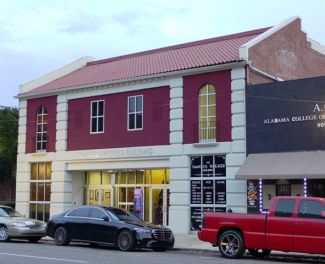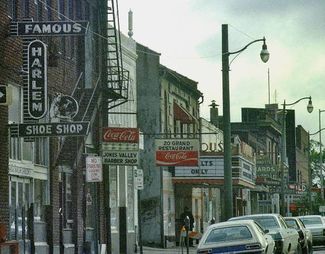Famous Theater: Difference between revisions
m (Famous Theatre moved to Famous Theater) |
No edit summary |
||
| (8 intermediate revisions by the same user not shown) | |||
| Line 1: | Line 1: | ||
The '''Famous | [[File:Famous Theater Building.jpg|right|thumb|325px|The Famous Theater Building in 2023]] | ||
[[File:Famous Theatre.jpg|right|thumb|325px|The Famous Theater in the 1940s]] | |||
[[File:1977 4th Ave N.jpg|right|thumb|325px|The Famous Theater in 1977]] | |||
The '''Famous Theater''' is a [[List of former cinemas|former cinema]] located in the historically-black [[4th Avenue Historic District|Business District]] at 1721 [[4th Avenue North]] in [[Birmingham]]. | |||
In [[1922]] the theater was owned by [[P. A. Englor]] the white manager of the [[Champion Theater]] nearby, but staffed by African-Americans. During the silent film era, most features at the Famous were accompanied by a pianist while [[Wilson Driver]] played drums, provided sound effects, and sang. In [[1925]] a guidebook gave the theater's address as 306 [[18th Street North]]. | |||
In the 1970s the theater showed adult films. After the theater closed, the building housed the offices of the [[Birmingham Urban League]] until [[2001]]. | |||
In [[2006]] attorney and architect [[Nolanda Hatcher|Nolanda Hatcher Bearden]] purchased the vacant building for $250,000 and gutted it. Beginning in [[2008]] she redeveloped it as a residence for herself and offices for her architecture firm, [[NHB Group]]. The building also has two other office spaces and three additional residential units for lease. The project was supported by $10,000 in city-backed incentives. | |||
In [[2015]] Hatcher merged her firm with [[Hoskins Architecture]], with offices in the theater building. | |||
{{stub}} | {{stub}} | ||
==References== | ==References== | ||
* Cooper, Lauren B. (May 23, 2008) "Developer moves forward on Famous Theater plan." | * "Colored theaters in Birmingham, Ala." (December 16, 1922) ''The Billboard'' | ||
* Cooper, Lauren B. (May 23, 2008) "Developer moves forward on Famous Theater plan." {{BBJ}} | |||
* Williams, Roy L. (October 21, 2009) "Birmingham architect, lawyer giving new life to former Famous Theater." {{BN}} | |||
[[Category:1927 buildings]] | |||
[[Category:2009 buildings]] | |||
[[Category:Former cinemas]] | [[Category:Former cinemas]] | ||
[[Category: | [[Category:Famous Theater|*]] | ||
Latest revision as of 14:52, 22 December 2023
The Famous Theater is a former cinema located in the historically-black Business District at 1721 4th Avenue North in Birmingham.
In 1922 the theater was owned by P. A. Englor the white manager of the Champion Theater nearby, but staffed by African-Americans. During the silent film era, most features at the Famous were accompanied by a pianist while Wilson Driver played drums, provided sound effects, and sang. In 1925 a guidebook gave the theater's address as 306 18th Street North.
In the 1970s the theater showed adult films. After the theater closed, the building housed the offices of the Birmingham Urban League until 2001.
In 2006 attorney and architect Nolanda Hatcher Bearden purchased the vacant building for $250,000 and gutted it. Beginning in 2008 she redeveloped it as a residence for herself and offices for her architecture firm, NHB Group. The building also has two other office spaces and three additional residential units for lease. The project was supported by $10,000 in city-backed incentives.
In 2015 Hatcher merged her firm with Hoskins Architecture, with offices in the theater building.
References
- "Colored theaters in Birmingham, Ala." (December 16, 1922) The Billboard
- Cooper, Lauren B. (May 23, 2008) "Developer moves forward on Famous Theater plan." Birmingham Business Journal
- Williams, Roy L. (October 21, 2009) "Birmingham architect, lawyer giving new life to former Famous Theater." The Birmingham News


